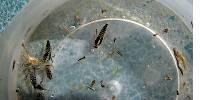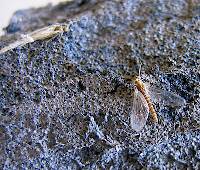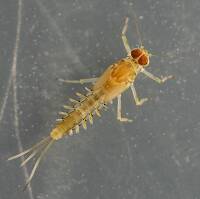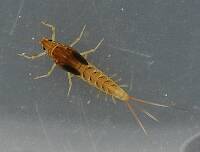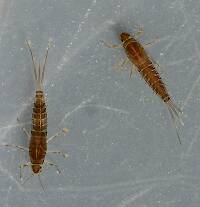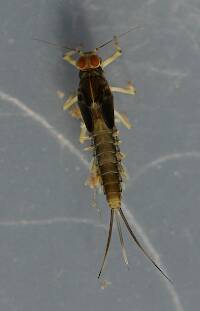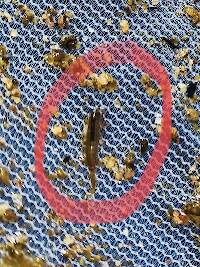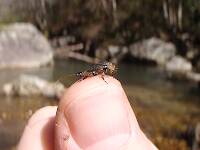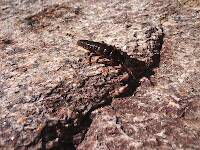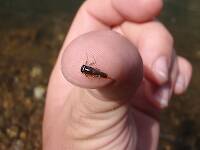
Blue-winged Olives
Baetis
Tiny Baetis mayflies are perhaps the most commonly encountered and imitated by anglers on all American trout streams due to their great abundance, widespread distribution, and trout-friendly emergence habits.
Featured on the forum

This specimen keys pretty easily to Onocosmoecus, and it closely resembles a specimen from Alaska which caddis expert Dave Ruiter recognized as this genus. As with that specimen, the only species in the genus documented in this area is Onocosmoecus unicolor, but Dave suggested for that specimen that there might be multiple not-yet-distinguished species under the unicolor umbrella and it would be best to stick with the genus-level ID. I'm doing the same for this one.

Troutnut is a project started in 2003 by salmonid ecologist Jason "Troutnut" Neuswanger to help anglers and
fly tyers unabashedly embrace the entomological side of the sport. Learn more about Troutnut or
support the project for an enhanced experience here.
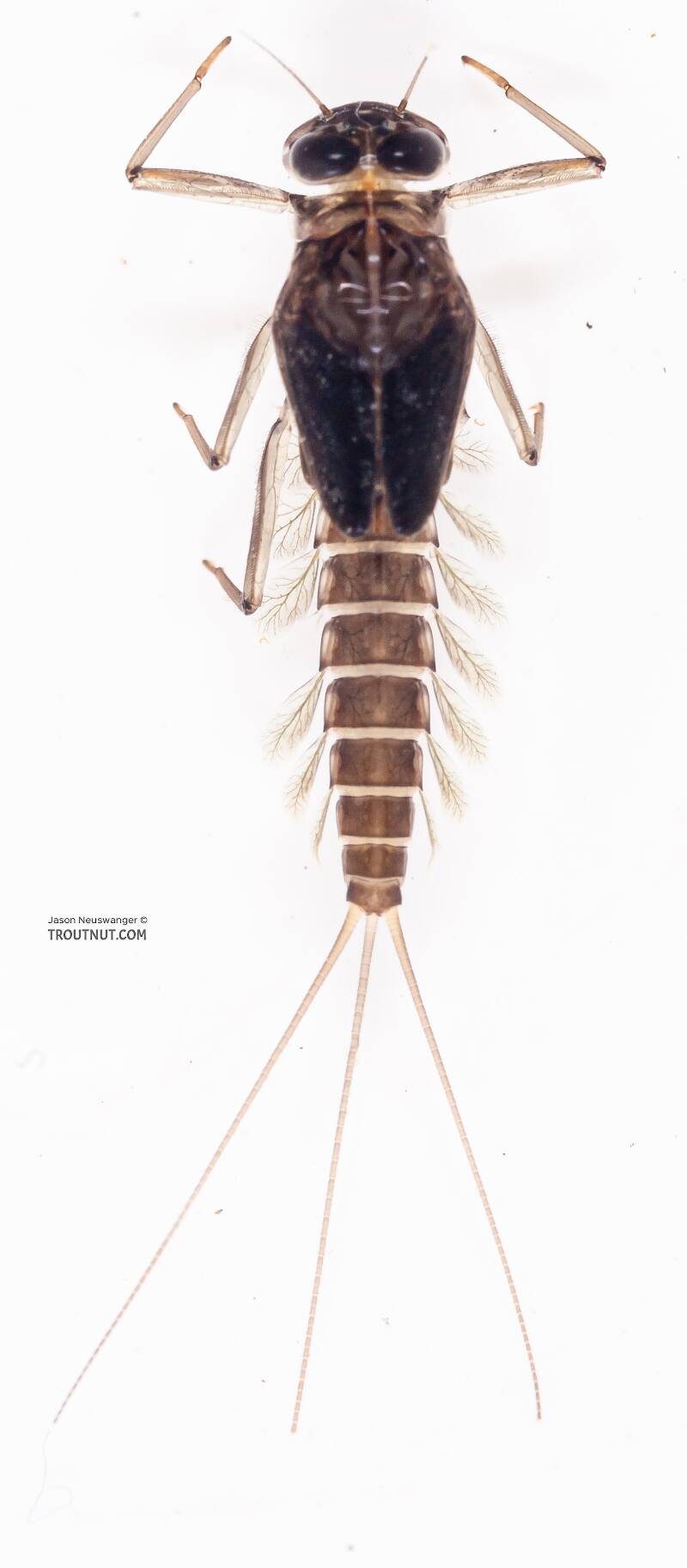
This very strange nymph appears to be undoubtedly Cinygmula, yet it lacks the telltale protruding mouthparts that usually make that genus so easy to identify.
Troutnut on Jul 20, 2011July 20th, 2011, 1:03 am EDT
I've never heard of such a thing, yet here it is, unless I'm badly mistaken. The gills and all the other features scream Cinygmula, as does the fact that it was collected with hundreds of other Cinygmula nymphs representing (I think) at least two species.
Anyone know what's going on with the mouth?
Anyone know what's going on with the mouth?
Jason Neuswanger, Ph.D.
Troutnut and salmonid ecologist
Troutnut and salmonid ecologist
Konchu on Jul 20, 2011July 20th, 2011, 4:27 am EDT
sometimes things look a little different before they molt to the subimago (as yours appears prepared to do), but i'm not sure that's the case here. again, maybe I can take a look at the real thing. i'll spend more time with the pictures later; I'll think about it today and possibly check some resources if I get a chance. the id here should be straight forward.
Troutnut on Jul 20, 2011July 20th, 2011, 9:15 am EDT
Interesting. I'll be sending this one to you labeled "Odd Cinygmula?"
Jason Neuswanger, Ph.D.
Troutnut and salmonid ecologist
Troutnut and salmonid ecologist
Entoman on Jul 20, 2011July 20th, 2011, 9:34 am EDT
Hi Luke & Jason,
Well, I don't know what to think. At first glance it looks a lot like the photos we tentatively placed in ramaleyi. The abdomen, gills and tails are clearly Cinygmula. The rest? Not so sure. The ventral shots show that the maxillary palpi are shorter, not held at a weird angle or something. In addition to the palpi "not looking the way they are supposed to", ditto the very thin femora. Also, the eyes lack the concavity or flat surface giving the eyes a more angled look to them as normally associated with this genera. This is definitely something different from what we are used to looking at with this genus.
regards,
Kurt
Well, I don't know what to think. At first glance it looks a lot like the photos we tentatively placed in ramaleyi. The abdomen, gills and tails are clearly Cinygmula. The rest? Not so sure. The ventral shots show that the maxillary palpi are shorter, not held at a weird angle or something. In addition to the palpi "not looking the way they are supposed to", ditto the very thin femora. Also, the eyes lack the concavity or flat surface giving the eyes a more angled look to them as normally associated with this genera. This is definitely something different from what we are used to looking at with this genus.
regards,
Kurt
"It's not that I find fishing so important, it's just that I find all other endeavors of Man equally unimportant... And not nearly as much fun!" Robert Traver, Anatomy of a Fisherman
Konchu on Jul 20, 2011July 20th, 2011, 3:27 pm EDT
Just for kicks, Jason, try running it through the recent key to Heptageniidae genera.
Entoman on Jul 20, 2011July 20th, 2011, 7:21 pm EDT
Hi Luke -
I tried the link and couldn't gain access to the full key. Is the presence of fibrilliform portions of the gilling no longer required to be Heptagenia?
Kurt
I tried the link and couldn't gain access to the full key. Is the presence of fibrilliform portions of the gilling no longer required to be Heptagenia?
Kurt
"It's not that I find fishing so important, it's just that I find all other endeavors of Man equally unimportant... And not nearly as much fun!" Robert Traver, Anatomy of a Fisherman
GONZO on Jul 20, 2011July 20th, 2011, 8:48 pm EDT
Kurt,
Dialog box 29b, the one that concludes with a determination of Heptagenia, says "gills 7 with fibrils." That doesn't seem any different.
Dialog box 29b, the one that concludes with a determination of Heptagenia, says "gills 7 with fibrils." That doesn't seem any different.
Konchu on Jul 21, 2011July 21st, 2011, 3:50 am EDT
I tried the link and couldn't gain access to the full key.
Try clicking on "larva key" at the bottom of the page that comes up from my link.
Jmw975 on Jul 25, 2011July 25th, 2011, 4:33 am EDT
Hi Jason,
It definitely looks like Cinygmula to me as well, but it is weird that the maxillae seem shorter. Cinygmula is poorly known in the nymphal stage, and it is possible this represents an undescribed one with shorter maxillae. In some of the preserved material I've seen the mouthparts don't always protrude, but I've never been confident in putting a species name on them (or pretty much any Cingymula nymph, for that matter). Also, like Konchu says, when things are getting ready to moult, they get all crazy (I think it happens just to confuse us!). It might be worthwhile getting DNA from this strange critter!
Jeff
It definitely looks like Cinygmula to me as well, but it is weird that the maxillae seem shorter. Cinygmula is poorly known in the nymphal stage, and it is possible this represents an undescribed one with shorter maxillae. In some of the preserved material I've seen the mouthparts don't always protrude, but I've never been confident in putting a species name on them (or pretty much any Cingymula nymph, for that matter). Also, like Konchu says, when things are getting ready to moult, they get all crazy (I think it happens just to confuse us!). It might be worthwhile getting DNA from this strange critter!
Jeff
Entoman on Jul 28, 2011July 28th, 2011, 4:29 pm EDT
sometimes things look a little different before they molt to the subimago...
Ah! You're right Luke. Thanks for reminding that head capsules of nymphs can change dramatically when close to emergence. Ephemerellid males in particular start to look like something from outerspace. This explains the difference in eye shape. Perhaps expansion of the head capsule or a withering of the mouthparts interiorly is behind the lack of protruding palpi?
Kurt
"It's not that I find fishing so important, it's just that I find all other endeavors of Man equally unimportant... And not nearly as much fun!" Robert Traver, Anatomy of a Fisherman
Entoman on Mar 28, 2013March 28th, 2013, 2:38 pm EDT
Not that I'm aware of.
"It's not that I find fishing so important, it's just that I find all other endeavors of Man equally unimportant... And not nearly as much fun!" Robert Traver, Anatomy of a Fisherman
Quick Reply
Related Discussions
Topic
Replies
Last Reply
3
Apr 26, 2010
by RyanBednar
by RyanBednar
0
Aug 12, 2012
by Hdhungryman
by Hdhungryman
Re: Nice pictures of accompanying Epoicocladius sp. larvae
In Ephemera simulans Mayfly Nymph by Beardius
In Ephemera simulans Mayfly Nymph by Beardius
3
Aug 8, 2008
by Beardius
by Beardius





